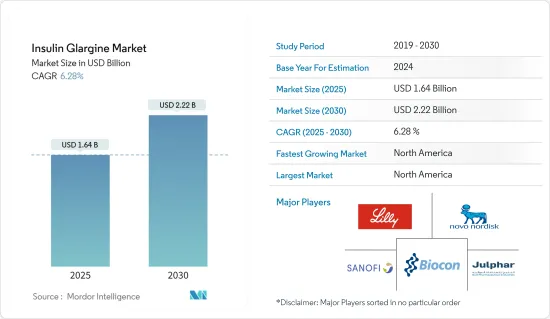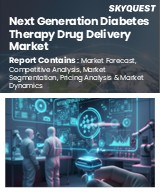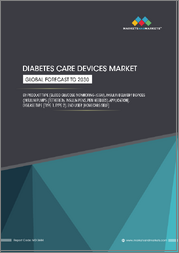
|
시장보고서
상품코드
1692133
인슐린 글라진 : 시장 점유율 분석, 산업 동향, 통계, 성장 예측(2025-2030년)Insulin Glargine - Market Share Analysis, Industry Trends & Statistics, Growth Forecasts (2025 - 2030) |
||||||
인슐린 글라진 시장 규모는 2025년에 16억 4,000만 달러, 2030년에는 22억 2,000만 달러에 달할 것으로 예측됩니다. 예측 기간(2025-2030년)의 CAGR은 6.28%를 나타낼 전망입니다.

COVID-19 팬데믹은 당뇨병 합병증 급증을 초래하여 시장에서 인슐린 수요가 급증하고 있습니다. 제1형 당뇨병은 인슐린을 필요로 하는 당뇨병이며 제2형 당뇨병은 인슐린 의존성 당뇨병입니다. 당뇨병 환자는 당뇨병이 아닌 사람에 비해 입원 위험이 300% 증가하기 때문에 비 당뇨병 환자보다 건강 관리 비용이 많이 듭니다.제2형 당뇨병 환자들은 추가 인슐린 투여나 추가 탄수화물 섭취와 같은 명목 혈당 수치를 유지하기 위해 하루 종일 많은 교정이 필요합니다. 매일 여러 번 인슐린을 주사하거나 인슐린 펌프 요법을 수행하지 않으면 명목상의 결과를 얻는 것이 매우 어렵습니다. 이는 전 세계적으로 인슐린 수요를 증가시키고 있으며 예측 기간 동안 시장 조사를 뒷받침할 것으로 예상됩니다.
인슐린 글라진 시장 동향
인슐린 글라진 시장에 대한 접근성 확대
Sanofi는 성인의 제1형 및 제2형 당뇨병 치료를 위한 기초 인슐린으로 유럽에서 Toujeo를 출시했습니다. 사노피의 데이터에 따르면, 2020년 Toujeo의 매출은 전 세계에서 9억 3,300만 유로가 되었고, 주로 유럽 국가에서의 호조적인 실적이 견인했습니다. 2020년 1월, 사노피는 유럽위원회(EC)가 Toujeo(인슐린 글라진 300단위/mL)의 현재 적응증을 소아 및 청소년 당뇨병으로 확대했다고 발표했습니다. 이로써, 투지오는 성인, 청소년, 6세 미만의 어린이의 당뇨병 치료에 사용하게 되었습니다. 한편, 바사그라는 란타스의 바이오시밀러로 처음으로 유럽의 일부 국가에서 최초로 출시되었습니다. 바사글러는 환자에게 란타스의 핵심 단백질 서열을 제공합니다. 바사글러는 주로 유럽의 채용이 확대되고 경쟁 제품보다 비용이 적기 때문에 예측 기간 동안 판매량이 비약적으로 증가할 것으로 예상됩니다.
시장 점유율의 약 56%를 차지하는 미국은 휴머로그의 세계 최대 매출을 자랑합니다. 당뇨병 치료제 제조업체의 대부분은 이 나라를 전 세계 매출을 높이는 중요한 시장으로 간주합니다. 휴머로그는 당뇨병 치료제로서 미국에서는 휴머로그 믹스 75/25, 휴머로그 U-100, 휴머로그 U-200, 휴머로그 믹스 50/50 등 많은 브랜드명으로 판매되고 있습니다. 모든 제1형 당뇨병 환자 및 일부 제2형 당뇨병 환자는 치료의 일환으로 매일 인슐린 주사가 필요합니다. ADA에 따르면 미국에서는 당뇨병 치료비의 67.3%를 정부 보험(메디케어, 메디케이드, 군 포함)이 부담하고 있습니다. 민간보험(30.7%)과 무보험자(2%)가 각각 남은 금액을 충당하고 있습니다.
북미가 예측기간 중 가장 높은 CAGR로 성장
의료기술이나 의료제도의 진보에도 불구하고, 이 지역의 환자는 만성질환의 과제를 다루지 못하고 있습니다. 이러한 질병의 발생률은 지난 몇 년동안 크게 증가했습니다. 북미에서는 합리적인 가격으로 기존 인간 인슐린 시장 점유율이 높습니다. 노보린은 80% 이상의 높은 시장 점유율을 차지하고 있으며, 흐물린과 인스만이 이어지고 있습니다. 그러나 이러한 전통 브랜드는 현지 의약품 시장과의 치열한 경쟁에 직면하고 있습니다. 장기간 작용하는 인슐린 제형 분야에서 란타스는 39.6% 이상의 최고 점유율을 차지한 다음 레베밀이 계속됩니다. Toujeo, Tresiba, Basaglar와 같은 차세대 인슐린 글라진은 일부 국가에서만 사용할 수 있습니다. 이 약들은 시장에 나온 국가에서 순조롭게 시장에 침투합니다.
북미, 특히 미국은 앉아서 생활하는 생활 방식으로 인해 초래하는 당뇨병 이환율이 높기 때문에 현재 세계 인슐린 시장을 독점하고 있습니다. 인슐린 제조업체의 수익의 50% 가까이가 미국 내에서 차지하고 있는 미국에서는 비용면이 최대의 걱정입니다. 세계에서 판매되고 있는 장시간 작용형 인슐린 제제 「란타스」의 대부분은 미국에서 판매되고 있습니다. 당뇨병 치료제 제조업체의 대부분은 미국을 전 세계 매출을 늘리기 위한 중요한 시장으로 자리매김하고 있습니다. 란타스는 미국에서 불균형할 정도로 큰 시장 점유율을 차지하고 있으며 세계적으로 가장 많이 사용되는 기초 인슐린입니다. 환자가 경제적으로 입수하기 쉽기 때문에 기존의 북미 인간 인슐린 의약품 시장은 예측 기간을 통해 확대될 것으로 예상되고 있습니다. 시장 점유율 상단은 Humulin이며 Novolin이 이어집니다. 미국의 전통적인 북미 인간 인슐린 의약품 시장에는 제네릭 의약품 라이벌이 없습니다.
인슐린 글라진 산업 개요
세계의 인슐린 글라진 시장은 세계 시장에서 존재감을 나타내는 주요 제조업체 3사(사노피, 노보놀디스크, 엘리 릴리)로 구성되어 있습니다. 나머지 제조업체는 다른 지역별 또는 로컬 제조업체로 제한됩니다. 최근, 각 제조업체간에 합병이나 인수가 행해져, 시장에서의 존재감을 높이고 있습니다. Eli Lilly와 Boehringer Ingelheim은 Basaglar(인슐린 글라르긴)의 개발 및 상업화에 제휴했으며 Biocon은 Semglee(인슐린 글라진의 바이오 시밀러) 개발에서 Mylan과 제휴했습니다. 사노피, 노보 노르디스크, 릴리 등의 유력 기업은 확립된 공급망과 브랜드력에 의해 시장을 독점하고 있으며, 그 결과 시장에 침투가 진행되고 있습니다. 이들 기업은 여러 행정기관 및 보건기구와 협력하여 경쟁 전략을 개발하고 신흥 시장 기업의 경쟁을 제한하거나 제거합니다.
기타 혜택 :
- 엑셀 형식 시장 예측(ME) 시트
- 3개월간의 애널리스트 및 지원
목차
제1장 서론
- 조사의 전제조건과 시장 정의
- 조사 범위
제2장 조사 방법
제3장 주요 요약
제4장 시장 역학
- 시장 개요
- 시장 성장 촉진요인
- 시장 성장 억제요인
- Porter's Five Forces 분석
- 공급기업의 협상력
- 구매자 및 소비자의 협상력
- 신규 참가업체의 위협
- 대체품의 위협
- 경쟁 기업간 경쟁 관계의 강도
제5장 시장 세분화
- 인슐린 라르긴
- Lantus
- Basaglar
- Toujeo
- Soliqua, Suliqua
- 인슐린 랄긴 바이오시밀러
- 지역
- 북미
- 미국
- 캐나다
- 기타 북미
- 유럽
- 프랑스
- 독일
- 이탈리아
- 스페인
- 영국
- 러시아
- 기타 유럽
- 라틴아메리카
- 멕시코
- 브라질
- 기타 라틴아메리카
- 아시아태평양
- 일본
- 한국
- 중국
- 인도
- 호주
- 베트남
- 말레이시아
- 인도네시아
- 필리핀
- 태국
- 기타 아시아태평양
- 중동 및 아프리카
- 사우디아라비아
- 이란
- 이집트
- 오만
- 남아프리카
- 기타 중동 및 아프리카
- 북미
제6장 시장 지표
- 제1형 당뇨병 인구
- 제2형 당뇨병 인구
제7장 경쟁 구도
- 기업 프로파일
- Novo Nordisk AS
- Sanofi Aventis
- Eli Lilly and Company
- Biocon
- Julphar
- 기업 점유율 분석
제8장 시장 기회와 앞으로의 동향
SHW 25.04.09The Insulin Glargine Market size is estimated at USD 1.64 billion in 2025, and is expected to reach USD 2.22 billion by 2030, at a CAGR of 6.28% during the forecast period (2025-2030).

The COVID-19 pandemic has resulted in a surge in diabetic complexities, which is driving the insulin demand in the market. Type 1 diabetes can be characterized as insulin-requiring, while Type 2 diabetes can be characterized as insulin-dependent diabetes. People with diabetes have a 300% increased risk of being hospitalized compared to those without diabetes, and, thus, they incur more healthcare expenses than non-diabetic people. Patients with Type 2 diabetes require many corrections throughout the day to maintain nominal blood glucose levels, such as the administration of additional insulin or ingestion of additional carbohydrates. Achieving nominal results can be very difficult without multiple daily injections of insulin or insulin pump therapy. This is driving the demand for insulin on a global scale, which is expected to drive the market studied during the forecast period.
Insulin Glargine Market Trends
Insulin Glargine Market Access has Widened
Sanofi released Toujeo in the European region as the basal insulin for the treatment of type-1 and type-2 diabetes mellitus in adults. According to Sanofi data, Toujeo reported net sales of EUR 933 million globally in 2020, driven primarily by strong performances in European nations. In January 2020, Sanofi announced that the European Commission (EC) had expanded the current indication for Toujeo (insulin glargine 300 units/mL) to include children and adolescents with diabetes. Toujeo is now indicated for the treatment of diabetes mellitus in adults, adolescents, and children under the age of 6 years. This is driving the market in the forecast period, whereas Basaglar was the first biosimilar to Lantus to be launched in some European countries. It offers the core protein sequence of Lantus to patients. It is expected to observe an exponential increase in sales volumes during the forecast period, primarily due to its growing adoption and lower cost than its competitors in the European region.
With approximately 56% of the market share, the United States has the biggest global sales of Humalog. The majority of diabetic medicine producers view the nation as a crucial market for boosting overall worldwide sales. For the treatment of diabetes, Humalog is marketed in the US under many brand names, including Humalog Mix 75/25, Humalog U-100, Humalog U-200, and Humalog Mix 50/50. All type-1 diabetics, as well as a tiny proportion of type-2 diabetics, require daily insulin injections as part of their treatment. According to the ADA, government insurance (including Medicare, Medicaid, and the military) pays for 67.3% of the cost of diabetes care in the US. Private insurance (30.7%) and uninsured people (2%), respectively, fund the remaining amount.
North America to Grow with the Highest CAGR over the Forecast Period
Despite advancements in medical technology and health systems, patients in this region are not coping with the challenges of chronic diseases. The incidence of these diseases increased significantly over the past few years. In North America, the market share of traditional human insulin is higher due to its affordability. Novolin holds the highest market share of more than 80%, followed by Humulin and Insuman. However, these traditional brands are facing fierce competition from the local drug market. Among the drugs in the long-acting insulin segment, Lantus holds the highest market share of more than 39.6%, followed by Levemir. New-generation insulin glargine, like Toujeo, Tresiba, and Basaglar, are available in only a few countries. These drugs witnessed good market penetration in the countries they were launched.
Due to the high incidence of diabetes in the region brought on by a sedentary lifestyle, North America, and specifically the United States, now hold a monopoly on the worldwide human insulin market. In the United States, where nearly 50% of the earnings for the makers of insulin come from within the nation, the cost aspect is the main worry. The majority of long-acting insulin, Lantus, sold worldwide is in the United States. The majority of diabetic medicine producers view the nation as a crucial market for boosting overall worldwide sales. Lantus has a disproportionately large market share in the US and is the most often used basal insulin globally. Because it is economically accessible to patients, the conventional North American human insulin pharmaceuticals market is anticipated to expand throughout the projected period. The market share leader is Humulin, followed by Novolin. The conventional North American human insulin medication market in the United States has no generic rivals.
Insulin Glargine Industry Overview
The global insulin glargine market is moderately consolidated, mainly consisting of three major manufacturers (Sanofi, Novo Nordisk, and Eli Lilly) with a global market presence. The remaining manufacturers are confined to the other local or region-specific manufacturers. Mergers and acquisitions that happened between the players in the recent past helped the companies strengthen their market presence. Eli Lilly and Boehringer Ingelheim have an alliance in developing and commercializing Basaglar (insulin glargine), whereas Biocon collaborated with Mylan to develop Semglee (an insulin glargine biosimilar). Prominent players, such as Sanofi, Novo Nordisk, and Lilly, have created a monopoly in the market through their established supply chains and branding, which has resulted in substantial market penetration. These companies work in tandem with several administrative and health agencies to deploy competitive strategies and restrict or eliminate competition from emerging market players.
Additional Benefits:
- The market estimate (ME) sheet in Excel format
- 3 months of analyst support
TABLE OF CONTENTS
1 INTRODUCTION
- 1.1 Study Assumptions and Market Definition
- 1.2 Scope of the Study
2 RESEARCH METHODOLOGY
3 EXECUTIVE SUMMARY
4 MARKET DYNAMICS
- 4.1 Market Overview
- 4.2 Market Drivers
- 4.3 Market Restraints
- 4.4 Porter's Five Forces Analysis
- 4.4.1 Bargaining Power of Suppliers
- 4.4.2 Bargaining Power of Buyers/Consumers
- 4.4.3 Threat of New Entrants
- 4.4.4 Threat of Substitute Products
- 4.4.5 Intensity of Competitive Rivalry
5 MARKET SEGMENTATION
- 5.1 Insulin Glargine
- 5.1.1 Lantus
- 5.1.2 Basaglar
- 5.1.3 Toujeo
- 5.1.4 Soliqua/Suliqua
- 5.1.5 Insulin Glargine Biosimilars
- 5.2 Geography
- 5.2.1 North America
- 5.2.1.1 United States
- 5.2.1.2 Canada
- 5.2.1.3 Rest of North America
- 5.2.2 Europe
- 5.2.2.1 France
- 5.2.2.2 Germany
- 5.2.2.3 Italy
- 5.2.2.4 Spain
- 5.2.2.5 United Kingdom
- 5.2.2.6 Russia
- 5.2.2.7 Rest of Europe
- 5.2.3 Latin America
- 5.2.3.1 Mexico
- 5.2.3.2 Brazil
- 5.2.3.3 Rest of Latin America
- 5.2.4 Asia-Pacific
- 5.2.4.1 Japan
- 5.2.4.2 South Korea
- 5.2.4.3 China
- 5.2.4.4 India
- 5.2.4.5 Australia
- 5.2.4.6 Vietnam
- 5.2.4.7 Malaysia
- 5.2.4.8 Indonesia
- 5.2.4.9 Philippines
- 5.2.4.10 Thailand
- 5.2.4.11 Rest of Asia-Pacific
- 5.2.5 Middle East and Africa
- 5.2.5.1 Saudi Arabia
- 5.2.5.2 Iran
- 5.2.5.3 Egypt
- 5.2.5.4 Oman
- 5.2.5.5 South Africa
- 5.2.5.6 Rest of Middle East and Africa
- 5.2.1 North America
6 MARKET INDICATORS
- 6.1 Type-1 Diabetes Population
- 6.2 Type-2 Diabetes Population
7 COMPETITIVE LANDSCAPE
- 7.1 Company Profiles
- 7.1.1 Novo Nordisk AS
- 7.1.2 Sanofi Aventis
- 7.1.3 Eli Lilly and Company
- 7.1.4 Biocon
- 7.1.5 Julphar
- 7.2 Company Share Analysis

















